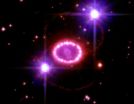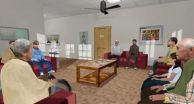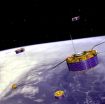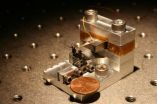(Press-News.org) Observations made with NASA's newly refurbished Hubble Space Telescope of a nearby supernova are allowing astronomers to measure the velocity and composition of "star guts" being ejected into space following the explosion, according to a new study led by the University of Colorado at Boulder.
The team detected significant brightening of the emissions from Supernova 1987A, which were consistent with some theoretical predictions about how supernovae interact with their immediate galactic environment. Discovered in 1987, Supernova 1987A is the closest exploding star to Earth to be detected since 1604 and resides in the nearby Large Magellanic Cloud, a dwarf galaxy adjacent to our own Milky Way Galaxy.
The team observed the supernova in optical, ultraviolet and near-infrared light, charting the interplay between the stellar explosion and the famous "String of Pearls," a glowing ring 6 trillion miles in diameter encircling the supernova remnant that has been energized by X-rays. The gas ring likely was shed some 20,000 years before the supernova exploded, and shock waves rushing out from the remnant have been brightening some 30 to 40 pearl-like "hot spots" in the ring -- objects that likely will grow and merge together in the coming years to form a continuous, glowing circle.
"The new observations allow us to accurately measure the velocity and composition of the ejected 'star guts,' which tell us about the deposition of energy and heavy elements into the host galaxy," said CU-Boulder Research Associate Kevin France of the Center for Astrophysics and Space Astronomy, lead study author. "The new observations not only tell us what elements are being recycled into the Large Magellanic Cloud, but how it changes its environment on human time scales."
A paper on the subject was published in the Sept. 2 issue of Science. The international study involved study co-authors from 15 other universities and institutes and included CU-Boulder astrophysicist Richard McCray, the Science paper's second author.
In addition to ejecting massive amounts of hydrogen, 1987A has spewed helium, oxygen, nitrogen and rarer heavy elements like sulfur, silicon and iron. Supernovae are responsible for a large fraction of biologically important elements, including oxygen, carbon and iron found in plants and animals on Earth today, he said. The iron in a person's blood, for example, is believed to have been made by supernovae explosions.
Hubble is the only observatory in the world that can observe the brightening of the String of Pearls in ultraviolet light, said France. Most of the data for the study was gathered by the Space Telescope Imaging Spectrograph, or STIS, which was installed on Hubble in 1997 and was one of the workhorse instruments before its power supply failed in 2004. A faulty circuit board on STIS was replaced by astronauts on the final Hubble repair mission in May 2009.
The team compared STIS observations in January 2010 with Hubble observations made over the past 15 years on 1987A's evolution. STIS has provided the team with detailed images of the exploding star, as well as spectrographic data -- essentially wavelengths of light broken down into colors like a prism that produce unique fingerprints of gaseous matter. The results revealed temperatures, chemical composition, density and motion of 1987A and its surrounding environment, said France.
Since the supernova is roughly 163,000 light-years away, the explosion occurred in roughly 161,000 B.C., said France. One light year is about 6 trillion miles.
"To see a supernova go off in our backyard and to watch its evolution and interactions with the environment in human time scales is unprecedented," he said. "The massive stars that produce explosions like Supernova 1987A are like rock stars -- they live fast, flashy lives and die young."
France said the energy input from supernovae regulates the physical state and the long-term evolution of galaxies like the Milky Way. Many astronomers believe a supernova explosion near our forming sun some 4 to 5 billion years ago is responsible for a significant fraction of radioactive elements in our solar system today, he said.
"In the big picture, we are seeing the effect a supernova can have in the surrounding galaxy, including how the energy deposited by these stellar explosions changes the dynamics and chemistry of the environment," said France. "We can use this new data to understand how supernova processes regulate the evolution of galaxies."
Some of the upcoming Hubble observations of Supernova 1987A will be made with the Cosmic Origins Spectrograph, a $70 million instrument designed by a team at CU-Boulder's Center for Astrophysics and Space Astronomy that was installed on Hubble during the 2009 servicing mission. The instrument is designed to help scientists better understand the "cosmic web" of material permeating the cosmos by gathering information from UV light from distant objects, allowing scientists to look back in time and space and reconstruct the condition and evolution of the early universe.
France became a member of the Cosmic Origins Spectrograph science team in 2007 and has been using data gathered by instrument to study topics ranging from the chemistry of the early universe about 2.5 billion years after the Big Bang occurred roughly 13.7 billion years ago, to the evaporation of the atmosphere around a planet that is orbiting another star. "COS has been extremely productive in the early phases of its mission and has great scientific breadth," said France.
###
Hubble observations of supernova reveal composition of 'star guts' pouring out
2010-09-04
ELSE PRESS RELEASES FROM THIS DATE:
Scientists discover the mechanisms and function of a type of mysterious immune cell
2010-09-04
LA JOLLA, CA – August 31, 2010 –– In two closely related studies, two teams of Scripps Research Institute scientists have discovered the underlying mechanisms that activate a type of immune cell in the skin and other organs. The findings may lead to the development of new therapies to treat inflammation, wounds, asthma, and malignant tumors.
The results of the two companion studies were published in the September 3, 2010 issue of the prestigious journal Science. Together, the new research sheds light on γδ (pronounced "gamma delta") T cells, an immune cell found ...
Protecting the lungs against 'collateral damage' from the immune system
2010-09-04
A study published today in the journal Science shows how our bodies try to minimise potential 'collateral damage' caused by our immune system when fighting infection. The research may also provide new clues to why cigarette smoke is a significant risk factor for developing diseases of the lung such as chronic bronchitis and emphysema.
When bacteria or viruses enter the body, our immune system fights back to neutralise any danger. One of the key 'soldiers' working for the immune system is a particular type of cell known as a neutrophil, which releases toxic enzymes to ...
Models suggest treatments for fractures that won't heal
2010-09-04
New models, reinforced by in vivo experimentation, show why 5-10% of bone fractures don't heal properly, and how these cases may be treated to restart the healing process. Results of the model, published September 2 in the open-access journal PLoS Computational Biology, may benefit the ageing population in which the occurrence of bone fractures is expected to rise substantially in the near future.
In 5 to 10% of bone fracture cases, the healing process does not succeed in repairing the bone, which leads to the formation of delayed unions or even non-unions - fractures ...
Ants take on Goliath role in protecting trees in the savanna from elephants
2010-09-04
GAINESVILLE, Fla. --- Ants are not out of their weight class when defending trees from the appetite of nature's heavyweight, the African elephant, a new University of Florida study finds.
Columns of angered ants will crawl up into elephant trunks to repel the ravenous beasts from devouring tree cover throughout drought-plagued East African savannas, playing a potentially important role in regulating carbon sequestration in these ecosystems, said Todd Palmer, a UF biology professor and co-author of a paper being published this week in the journal Current Biology.
"It ...
Study challenges value of oxygen therapy in end-of-life care
2010-09-04
DURHAM, N.C. – Millions of patients with advanced disease in palliative care settings receive oxygen therapy to help them breathe more easily. But a new study from Duke University Medical Center says roughly half of them don't benefit from the intervention, and among those who do benefit, it doesn't make a bit of difference whether they get pure oxygen or just plain old room air – both offer equal benefit.
"Offering oxygen when patients begin experiencing shortness of breath has become standard care in many places, but the practice is not based on rigorous scientific ...
Lupus Research Institute-funded study points to increased risk for lupus in men
2010-09-04
Lupus Research Institute-funded researcher Betty Tsao, PhD, at the University of California Los Angeles has discovered that humans—males in particular—with a variant form of the immune receptor gene "Toll Like Receptor 7 (TLR7)" are at increased risk of developing the autoimmune disease systemic lupus erythematosus (lupus). This breakthrough finding offers renewed hope for developing more targeted treatments.
The powerful finding recently published in the Proceedings of the National Academy of Sciences (PNAS) represents additional strong evidence from human cells—as opposed ...
Hip dysplasia susceptibility in dogs may be underreported, according to Penn Vet comparative study
2010-09-04
VIDEO:
Dr. Gail Smith, a veterinary orthopedic surgeon, discusses the PennHIP method for diagnosing a dog's susceptibility to osteoarthritis.
Click here for more information.
PHILADELPHIA –- A study comparing a University of Pennsylvania method for evaluating a dog's susceptibility to hip dysplasia to the traditional American method has shown that 80 percent of dogs judged to be normal by the traditional method are actually at risk for developing osteoarthritis and hip dysplasia, ...
Human unconscious is transferred to virtual characters
2010-09-04
Virtual characters can behave according to actions carried out unconsciously by humans. Researchers at the University of Barcelona have created a system which measures human physiological parameters, such as respiration or heart rate, and introduces them into computer designed characters in real time.
"The ultimate aim is to develop a method which allows humans to unconsciously relate with some parts of the virtual environment more intensely than with others, and that they are encouraged only by their own physiological responses to the virtual reality shown", Christoph ...
Cluster turns the invisible into the visible
2010-09-04
Cluster has spent a decade revealing previously hidden interactions between the Sun and Earth. Its studies have uncovered secrets of aurora, solar storms, and given us insight into fundamental processes that occur across the Universe. And there is more work to do.
The aurora, those dancing lights in the polar skies, are but the visible manifestation of an invisible battle taking place above our heads. Supersonic particles from the Sun collide with our planet's magnetic field every day. Most are deflected away but some are trapped by Earth's magnetism and accelerated to ...
Miniature auto differential helps tiny aerial robots stay aloft
2010-09-04
CAMBRIDGE, Mass., Sept. 2, 2010 -- Engineers at Harvard University have created a millionth-scale automobile differential to govern the flight of minuscule aerial robots that could someday be used to probe environmental hazards, forest fires, and other places too perilous for people.
Their new approach is the first to passively balance the aerodynamic forces encountered by these miniature flying devices, letting their wings flap asymmetrically in response to gusts of wind, wing damage, and other real-world impediments.
"The drivetrain for an aerial microrobot shares ...



